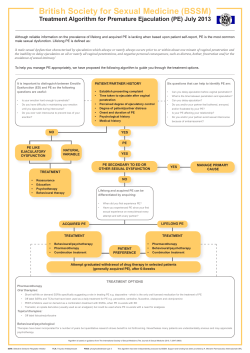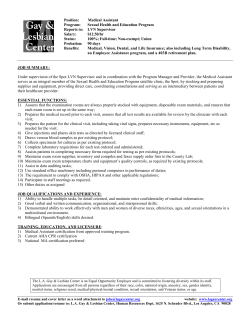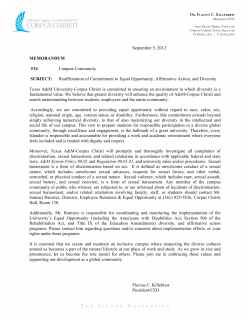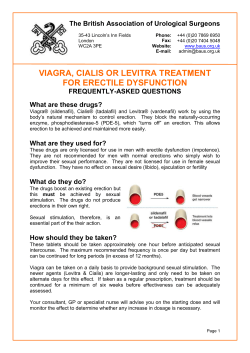
Sexual function problems and help seeking behaviour in Britain: national probability
Downloaded from bmj.com on 31 January 2006 Sexual function problems and help seeking behaviour in Britain: national probability sample survey Catherine H Mercer, Kevin A Fenton, Anne M Johnson, Kaye Wellings, Wendy Macdowall, Sally McManus, Kiran Nanchahal and Bob Erens BMJ 2003;327;426-427 doi:10.1136/bmj.327.7412.426 Updated information and services can be found at: http://bmj.com/cgi/content/full/327/7412/426 These include: References This article cites 3 articles, 1 of which can be accessed free at: http://bmj.com/cgi/content/full/327/7412/426#BIBL 5 online articles that cite this article can be accessed at: http://bmj.com/cgi/content/full/327/7412/426#otherarticles Rapid responses 3 rapid responses have been posted to this article, which you can access for free at: http://bmj.com/cgi/content/full/327/7412/426#responses You can respond to this article at: http://bmj.com/cgi/eletter-submit/327/7412/426 Email alerting service Topic collections Receive free email alerts when new articles cite this article - sign up in the box at the top right corner of the article Articles on similar topics can be found in the following collections Erectile dysfunction (43 articles) Clinical Research (620 articles) Sexual and gender disorders (35 articles) Correction A correction has been published for this article. The contents of the correction have been appended to the original article in this reprint. The correction is available online at: http://bmj.com/cgi/content/full/327/7416/649 Notes To order reprints of this article go to: http://www.bmjjournals.com/cgi/reprintform To subscribe to BMJ go to: http://bmj.bmjjournals.com/subscriptions/subscribe.shtml Downloaded from bmj.com on 31 January 2006 Primary care What is already known on this topic Little is known about the prevalence of sexual dysfunction in people attending their general practice and whether such problems are recognised by doctors Controversy exists about defining sexual dysfunction in terms of health and disease 1 2 3 4 5 6 What this study adds 7 22% of men and 40% of women received at least one ICD-10 diagnosis of sexual dysfunction according to stringent clinical criteria Older women with poorer physical and psychological function and who were dissatisfied with their sex life were more likely to have a ICD-10 diagnosis of sexual dysfunction, as were bisexual men 8 9 10 11 12 13 Although similar findings have been reported in men who report same sex behaviour,21 to our knowledge no other population study has focused specifically on sexual problems in bisexual as distinct from homosexual men. We thank Josephine Woolf for her collaboration in obtaining funding; Alice Gladwin, Monique Cloherty, and Üta Drescher for their assistance in collecting the data; and Bob Blizard for his statistical advice on the project. Contributors: See bmj.com Funding: health service research project grant provided by the Wellcome Trust (reference 991026); the North and Central Thames Research Network (NoCTeN) provided service support costs involved with the recruitment at the general practices. Competing interests: None declared. Ethical approval: Two London local research ethical committees approved the study. 14 15 16 17 18 19 20 21 Reynolds CF, Frank E, Thase ME, Houck PR, Jennings JR, Howell JR, et al. Assessment of sexual function in depressed, impotent, and healthy men: factor analysis of a brief sexual function questionnaire for men. Psychiatry Res 1987;24:231-50. Daker-White G. Reliable and valid self-report outcome measures in sexual dysfunction: a systematic review. Arch Sex Behav 2002;31:197-209. Taylor JF, Rosen RC, Leiblum SR. Self report assessment of female sexual function. Arch Sex Behav 1994;23:627-43. Kinsey AC, Pomeroy WB, Martin CE. Sexual behaviour in the human male. Philadelphia, PA: Saunders, 1948. World Health Organization. International statistical classification of disease and related health problems, 10th revision. Geneva: WHO, 1992. Ware JE, Kosinski M, Keller SD. A 12-item short-form health survey construction of scales and preliminary tests of reliability and validity. Med Care 1996;34:220-33. Goldberg D, Williams D. A user’s guide to the general health questionnaire. Windsor: NFER-Nelson, 1988. Ewing JA. Detecting alcoholism: the CAGE questionnaire. JAMA 1984;252:1905-7. Finkelhor D. Child sexual abuse. In: Rosenberg ML, Fenley MA, eds. Violence in America—a public health approach. New York: Oxford University Press, 1991:79-94. Crenshaw TL, Goldberg JP. Sexual pharmacology—drugs that affect sexual function. New York: Norton, 1996. McCormick A, Fleming D, Charlton J. Morbidity statistics from general practice—fourth national morbidity study 1991-1992. London: OPCS, HMSO, 1995. Peach C. Ethnicity in the 1991 census—the ethnic minority populations of Great Britain. Volume 2. London, Stationery Office, 1998:206-21. Johnson AM, Mercer CH, Erens B, Copas AJ, McManus S, Wellings K, et al. Sexual behaviour in Britain: partnerships, practices and HIV risk behaviours. Lancet 2001;358:1835-42. Laumann EO, Paik A, Rosen R. Sexual dysfunction in the United States: prevalence and indicators. JAMA 1999;281:537-44. Akkus E, Kadioglu A, Esen A, Doran S, Ergen A, Anafarta K, et al. Prevalence and correlates of erectile dysfunction in Turkey: a population based study. Eur Urol 2002;41:298-304. Mirone V, Imbimbo C, Bortolotti A, Di Cintio E, Colli E, Landoni M, et al. Cigarette smoking as a risk factor for erectile dysfunction: results from an Italian epidemiological study. Eur Urol 2002;41:294-7. Tiefer L. Sexology and the pharmaceutical industry: the threat of co-optation. J Sex Res 2000;37:273-83. Moynihan R. The making of a disease: female sexual dysfunction. BMJ 2003;236:45-7. Mercer CH, Fenton KA, Johnson AM, Wellings K, Macdowell W, McManus S, et al. Self reported sexual function problems and help seeking behaviour: results from a British probability sample survey. BMJ 2003 (in press). Humphery S, Nazareth I. GPs’ views on their management of sexual dysfunction. Fam Pract 2001;18:516-8. Moreira ED, Najjar Abdo CH, Barreto Torres E, Lisboa Lobo CF, Saraiva Fittipaldi JA. Prevalence and correlates of erectile dysfunction: results of the Brazilian study of sexual behaviour. Urology 2001:58:583-8. (Accepted 5 June 2003) Sexual function problems and help seeking behaviour in Britain: national probability sample survey Editorial by Ogden See also p 423 Centre for Infectious Disease Epidemiology, Department of Primary Care and Population Sciences and Department of Sexually Transmitted Diseases, Royal Free and University College Medical School, London WC1E 6AU Catherine H Mercer research fellow Anne M Johnson professor continued over BMJ 2003;327:426–7 426 Catherine H Mercer, Kevin A Fenton, Anne M Johnson, Kaye Wellings, Wendy Macdowall, Sally McManus, Kiran Nanchahal, Bob Erens The need for estimates of the extent of sexual function problems in the general population has become more urgent given recent debates surrounding the identification and definition of “sexual dysfunction,” the increased availability of pharmacological interventions, and possible changes in our expectations of what constitutes sexual function and fulfilment.1 We report results from the national survey of sexual attitudes and lifestyles (Natsal 2000). Participants, methods, and results Natsal 2000 was a stratified probability sample survey done between May 1999 and February 2001 of 11 161 men and women aged 16-44 years resident in Britain.2 3 The response rate was 65.4%. A computer assisted self interview asked participants about their sexual lifestyles and attitudes. We asked questions about their experience of sexual problems based on those used in the US national health and social life survey,4 which measured the main dimensions of sexual dysfunction, as defined in ICD-10 (international classification of diseases, 10th revision). We analysed data in STATA accounting for the sample’s stratification, clustering, and weighting.2 3 A total of 34.8% of men and 53.8% of women who had at least one heterosexual partner in the previous year reported at least one sexual problem lasting at least one month during this period (table). The most common problems among men were lacking interest BMJ VOLUME 327 23 AUGUST 2003 bmj.com Downloaded from bmj.com on 31 January 2006 Primary care Self reported problems related to sexual function by people who had at least one heterosexual partner in the previous year. Values are prevalences (95% confidence interval) Lasted at least one month in past year Problem Lack of interest in sex Lasted at least six months in past year Men Women Men Women 17.1 (15.8 to 18.4) 40.6 (39.2 to 42.1) 1.8 (1.4 to 2.3) 10.2 (9.4 to 11.1) 1.5 (1.1 to 1.9) Anxious about performance 9.0 (8.1 to 10.0) 6.7 (6.0 to 7.5) 1.8 (1.4 to 2.2) Unable to experience orgasm 5.3 (4.6 to 6.1) 14.4 (13.4 to 15.4) 0.7 (0.5 to 1.1) 3.7 (3.2 to 4.4) Premature orgasm 11.7 (10.6 to 12.9) 1.3 (1.0 to 1.7) 2.9 (2.4 to 3.6) 0.2 (0.1 to 0.3) Painful intercourse 1.7 (1.3 to 2.2) 11.8 (10.9 to 12.9) 0.3 (0.2 to 0.5) 3.4 (2.9 to 3.9) Unable to achieve or maintain erection 5.8 (5.0 to 6.6) — 0.8 (0.6 to 1.1) — Trouble lubricating — 9.2 (8.4 to 10.1) — 2.6 (2.2 to 3.2) At least one problem 34.8 (33.1 to 36.4) 53.8 (52.3 to 55.2) 6.2 (5.4 to 7.1) 15.6 (14.6 to 16.7) At least one problem excluding lack of interest in sex 24.1 (22.6 to 25.6) 29.0 (27.7 to 30.4) 5.0 (4.3 to 5.8) 8.9 (8.1 to 9.8) At least two problems 10.5 (9.5 to 11.6) 19.1 (18.0 to 20.3) 1.4 (1.0 to 1.8) 4.1 (3.6 to 4.8) At least two problems excluding lack of interest in sex 6.8 (6.0 to 7.7) 10.3 (9.4 to 11.2) 1.2 (0.9 to 1.6) 1.9 (1.5 to 2.3) Base (weighted, unweighted)* 4888, 3980 4826, 5530 4877, 3972 4818, 5518 *The base for sexual problems lasting longer than six months is slightly smaller than the base for any sexual problems reflecting non-response to the question which asked how long problems had lasted. in sex, premature orgasm, and anxiety about performance; and among women, inability to experience orgasm and painful intercourse. Persistent sexual problems—lasting at least six months in the previous year—were less prevalent among men (6.2%) than among women (15.6%). The most common persistent problem among men was premature orgasm and among women, lack of interest in sex. Among people who had sexual problems, 32.5% (95% confidence interval 29.7% to 35.3%) of men and 62.4% (60.4% to 64.3%) of women avoided sex because of their problems. Only 10.5% (8.8% to 12.4%) of men and 21.0% of women (19.3% to 22.7%) with problems in the previous year sought help. People with persistent problems were more likely to have sought help (20.5% (15.8% to 26.3%) of men and 31.9% (28.4% to 35.5%) of women). Among people seeking help, 63.8% (54.6% to 72.1%) of men and 74.3% (70.1% to 78.1%) of women consulted their general practitioner, and 9.2% (5.3% to 15.4%) of men and 4.8% (3.2% to 7.2%) of women sought help at a genitourinary clinic. of advice and treatment; more men present with sexual problems at genitourinary clinics since the licensing of sildenafil.5 People who often seek help consult their general practitioner but given the limited time and resources in this setting, such problems may be accorded low priority. Our data have implications for improving relationship education, counselling, medical education, and doctors’ professional development; raising public awareness of the range and location of services available for managing sexual problems; and re-examining the nature of “sexual dysfunction” and how best to tackle it. 1 3 Problems of sexual function are relatively common, but persistent problems are much less so. Inconsistent definitions make comparing prevalences with other studies difficult. Given the broad spectrum of problems, we have not sought to define clinical “dysfunction” but rather to describe the range of problems of sexual function in the population and to use duration of problems and avoidance of sex as indicators of severity. We asked specifically about problems that lasted more than one month in the previous year; but whether, for example, lacking interest in sex can be considered as “dysfunction” is questionable since it was reported by two fifths of women and one fifth of men. Few people sought help with their problems reflecting how severity varies, and how the need for professional intervention depends on the perceived importance to the patient and the underlying causes. Seeking help also reflects awareness of the availability BMJ VOLUME 327 23 AUGUST 2003 bmj.com Centre for Sexual and Reproductive Health Research, School of Hygiene and Tropical Medicine, London WC1E 7HT Kaye Wellings director Wendy Macdowall research fellow Kiran Nanchahal medical statistician National Centre for Social Research, London EC1V 0AX Sally McManus senior researcher Bob Erens health research group director Correspondence to: C H Mercer cmercer@gum. ucl.ac.uk Contributors: CHM was the lead writer of this paper and did all statistical analyses. KAF, AMJ, KW, and BE were coinvestigators and designed, implemented, and managed the study and prepared the manuscript. SMcM, KN, and WM also prepared the manuscript. CHM is guarantor. Funding: Medical Research Council, Department of Health, Scottish Executive, and National Assembly for Wales. Competing interests: None declared. 2 Comment HIV/STI Division, Communicable Disease Surveillance Centre, Health Protection Agency, London NW9 5EQ Kevin A Fenton consultant epidemiologist 4 5 Moynihan R. The making of a disease: female sexual dysfunction. BMJ 2003;326:45-7. Johnson AM, Mercer CH, Erens B, Copas AJ, McManus S, Wellings K, et al. Sexual behaviour in Britain: partnerships, practices, and HIV risk behaviours. Lancet 2001;358:1835-42. Erens B, McManus S, Field J, Korovessis C, Johnson AM, Fenton K, et al. National survey of sexual attitudes and lifestyles II: technical report. London: National Centre for Social Research, 2001. Laumann EO, Gagnon JH, Michael RT, Michaels S. The social organisation of sexuality: sexual practices in the United States. Chicago: University of Chicago Press, 1994. Kell P. The provision of sexual dysfunction services by genitourinary medicine physicians in the UK, 1999. Int J STD AIDS 2001;12:395-7. (Accepted 7 July 2003) Endpiece Angry Anyone can be angry—that is easy. But to be angry with the right person, to the right degree, at the right time, for the right purpose, and in the right way—this is not easy. Aristotle, Nicomachean Ethics John Spencer, consulting psychiatrist, north Derbyshire 427 Downloaded from bmj.com on 31 January 2006 Papers What is already known on this topic Psychological stress has been implicated as a determinant of disease activity in multiple sclerosis Evidence on the relation between stressful events and exacerbations of multiple sclerosis is lacking A recent report of the American Academy of Neurology emphasised the need to obtain tightly defined prospective data What this study adds Patients with multiple sclerosis who experience a stressful event are subsequently at increased risk of an exacerbation of their disease Stress and infection are independently associated with the risk of an exacerbation Stress and infection and the risk of an exacerbation Certain types of psychological stress can suppress immune reactions, leading to an increased susceptibility to infections.23 This would confound the positive association we found between stress and exacerbations. However, we found no evidence of an increase in infections after stressful events in this study. Stress and infection were independently associated with the risk of exacerbation. It will not be easy to tackle these factors in individual patients, because infections and stressful events cannot simply be eradicated from patients’ lives. The knowledge that stressful events are associated with disease activity adds important information to the limited insight that patients and their caregivers have on this unpredictable disease. We thank the late Monica van der Hoven, who performed secretarial and organisational tasks for this study, and to D Dippel for critical reading of the manuscript. Funding: Stichting Vrienden MS Research, the “Preventiefonds,” and Erasmus MC Rotterdam. Competing interests: None declared. Ethical approval: The medical ethical committee of Erasmus MC approved the study. 1 Sibley WA, Bamford CR, Clark K. Clinical viral infections and multiple sclerosis. Lancet 1985;i:1313-5. Buljevac D, Flach HZ, Hop WC, Hijdra D, Laman JD, Savelkoul HF, et al. Prospective study on the relationship between infections and multiple sclerosis exacerbations. Brain 2002;125:952-60. 3 Confavreux C, Hutchinson M, Hours MM, Cortinovis-Tourniaire P, Moreau T. Rate of pregnancy-related relapse in multiple sclerosis. N Engl J Med 1998;339:285-91. 4 Charcot JM. Lectures on the diseases of the nervous system. In: Lectures on the diseases of the nervous system. London: New Sydenham Society, 1879:157-222. 5 Warren S, Warren KG, Cockerill R. Emotional stress and coping in multiple sclerosis (MS) exacerbations. J Psychosom Res 1991;35:37-47. 6 Grant I, Brown GW, Harris T, McDonald WI, Patterson T, Trimble MR. Severely threatening events and marked life difficulties preceding onset or exacerbation of multiple sclerosis. J Neurol Neurosurg Psychiatry 1989;52:8-13. 7 Sibley WA. Risk factors in multiple sclerosis. In: Raine CS, McFarland HF, Tourtelotte WW, eds. Multiple sclerosis: clinical and pathogenetic basis. London: Chapman and Hall, 1997:141-8.. 8 Warren S, Greenhill S, Warren KG. Emotional stress and the development of multiple sclerosis: case-control evidence of a relationship. J Chronic Dis 1982;35:821-31. 9 Franklin GM, Nelson LM, Heaton RK, Burks JS, Thompson DS. Stress and its relationships to acute exacerbations in multiple sclerosis. J Neurol Rehabil 1988;2:7-11. 10 Schwartz CE, Foley FW, Rao SM, Bernardin LJ, Lee H, Genderson MW. Stress and course of disease in multiple sclerosis. Behav Med 1999;25:110-6. 2 BMJ VOLUME 327 20 SEPTEMBER 2003 bmj.com 11 Kroencke DC, Denney DR. Stress and coping in multiple sclerosis: exacerbation, remission and chronic subgroups. Mult Scler 1999;5: 89-93. 12 Goodin DS, Ebers GC, Johnson KP, Rodriguez M, Sibley WA, Wolinsky JS. The relationship of MS to physical trauma and psychological stress: report of the Therapeutics and Technology Assessment Subcommittee of the American Academy of Neurology. Neurology 1999;52:1737-45. 13 Schumacher GA, Beebe G, Kibler RF, Kurland LT, Kurtzke JF, McDowell F, et al. Problems of experimental trials of therapy in multiple sclerosis: report by the panel on the evaluation of experimental trials of therapy in multiple sclerosis. Ann N Y Acad Sci 1965;122:552-68. 14 Mohr DC, Goodkin DE, Bacchetti P, Boudewyn AC, Huang L, Marrietta P, et al. Psychological stress and the subsequent appearance of new brain MRI lesions in MS. Neurology 2000;55:55-61. 15 Cox DR. Regression models and life-tables. J Roy Stat Soc B 1972;34: 187-220. 16 Janssens ACJW, Van Doorn PA, de Boer JB, van der Meché FGA, Passchier J, Hintzen RQ. Impact of recently diagnosed multiple sclerosis on quality of life, anxiety, depression and distress of patients and partners. Acta Neurol Scand 2003 (in press). 17 Chelmicka-Schorr E, Arnason BG. Nervous system-immune system interactions and their role in multiple sclerosis. Ann Neurol 1994;36(suppl):s29-32. 18 Rabins PV, Brooks BR, O’Donnell P, Pearlson GD, Moberg P, Jubelt B, et al. Structural brain correlates of emotional disorder in multiple sclerosis. Brain 1986;109:585-97. 19 Nisipeanu P, Korczyn AD. Psychological stress as risk factor for exacerbations in multiple sclerosis. Neurology 1993;43:1311-2. 20 Sternberg EM. Neuroendocrine regulation of autoimmune/ inflammatory disease. J Endocrinol 2001;169:429-35. 21 Jafarian-Tehrani M, Sternberg EM. Animal models of neuroimmune interactions in inflammatory diseases. J Neuroimmunol 1999;100:13-20. 22 Antel JP, Owens T. Immune regulation and CNS autoimmune disease. J Neuroimmunol. 1999;100:181-9. 23 Sheridan JF, Dobbs C, Brown D, Zwilling B. Psychoneuroimmunology: stress effects on pathogenesis and immunity during infection. Clin Microbiol Rev 1994;7:200-12. (Accepted 17 July 2003) Corrections and clarifications Sexual function problems and help seeking behaviour in Britain: national probability sample study We inadvertently omitted from the main text (but not from the table) one of the main findings of this study by Catherine Mercer and colleagues (23 August, pp 426-7). We should have mentioned that the most common problem among women, as among men, was a lack of interest in sex. Also, in the final sentence of the penultimate paragraph, a misplaced word (“often”) changed the sense: the sentence should have said that people who seek help for their sexual function problems often consult their general practitioner. Wrong heading on BMJ cover We misrepresented on the cover of the issue of 2 August the paper by Michael J Radcliffe and colleagues (Enzyme potentiated desensitisation in treatment of seasonal allergic rhinitis: double blind randomised controlled study. BMJ 2003;327:251-4). Our heading suggested that desensitisation (of any type) for allergies does not work, whereas the paper by Radcliffe and colleagues referred specifically to enzyme potentiated desensitisation. Traditional desensitisation does in fact work for certain indications (for example, bee and wasp venom anaphylaxis; severe simple, grass pollen hay fever; and severe cat allergy). Unfortunately, we repeated our error in the first sentence of the summary in “This Week in the BMJ.” National survey of use of hospital beds by adolescents aged 12 to 19 in the United Kingdom An error in the figure in this paper by R M Viner has recently been brought to our attention—a couple of years after publication (BMJ 2001; 322:957-8). The legend within the graph should indicate that the top two curves relate to male inpatients (blue) and female inpatients (red) and that the bottom two relate to male and female day case patients (green and orange respectively). “Terminal sedation” different from euthanasia, Dutch ministers agree In this news article by Tony Sheldon, we attributed the wrong sex to the Dutch health minister (30 August, p 465). Clémence Ross is in fact a woman. 649
© Copyright 2025









